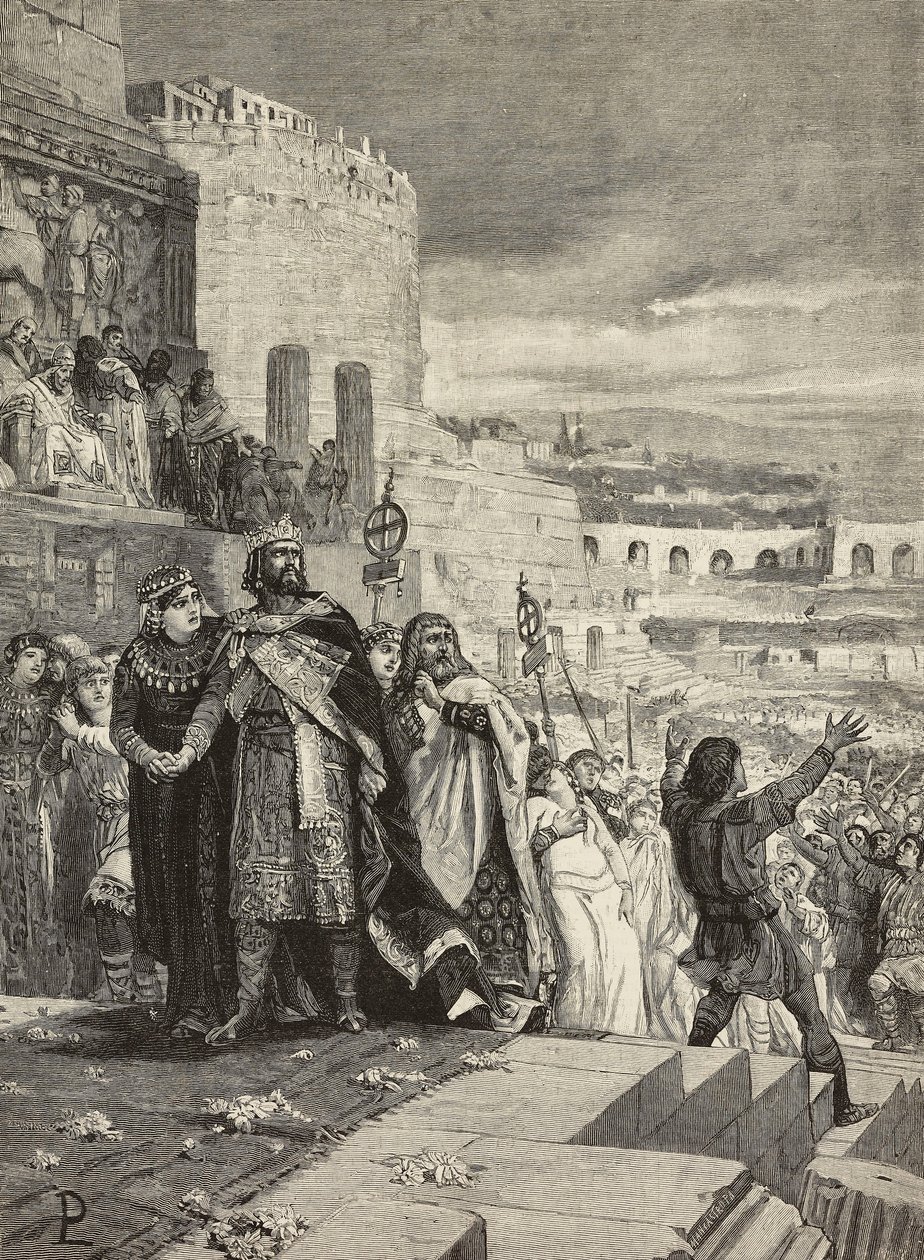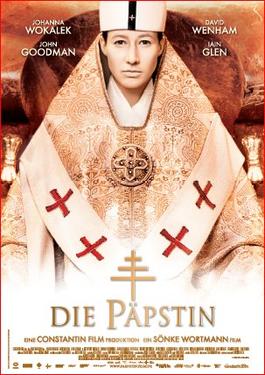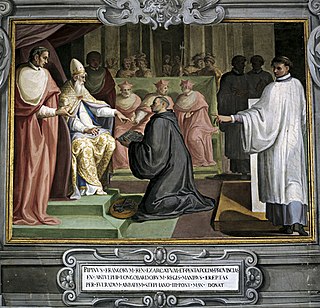
Pope Joan was, according to legend, a woman who reigned as pope for two years during the Middle Ages. Her story first appeared in chronicles in the 13th century and subsequently spread throughout Europe. The story was widely believed for centuries, but most modern scholars regard it as fictional.
Pope Anastasius III was the bishop of Rome and ruler of the Papal States from April 911 to his death.
Pope Benedict III was the bishop of Rome and ruler of the Papal States from 29 September 855 to his death.
Pope Benedict VIII was bishop of Rome and ruler of the Papal States from 18 May 1012 until his death. He was born Theophylact to the noble family of the counts of Tusculum. Unusually for a medieval pope, he had strong authority both in Rome and abroad.
Pope Stephen III was the bishop of Rome and ruler of the Papal States from 7 August 768 to his death. Stephen was a Benedictine monk who worked in the Lateran Palace during the reign of Pope Zachary. In the midst of a tumultuous contest by rival factions to name a successor to Pope Paul I, Stephen was elected with the support of the Roman officials. He summoned the Lateran Council of 769, which sought to limit the influence of the nobles in papal elections. The Council also opposed iconoclasm.

Pope Sergius I was the bishop of Rome from 15 December 687 to his death, and is revered as a saint by the Roman Catholic Church. He was elected at a time when two rivals, Paschal and Theodore, were locked in dispute about which of them should become pope. His papacy was dominated by his response to the Quinisext Council, the canons of which he steadfastly refused to accept. Thereupon Emperor Justinian II ordered Sergius' arrest, but the Roman people and the Italian militia of the exarch of Ravenna refused to allow the exarch to bring Sergius to Constantinople.
Pope Sergius III was the bishop of Rome and nominal ruler of the Papal States from 29 January 904 to his death. He was pope during a period of violence and disorder in central Italy, when warring aristocratic factions sought to use the material and military resources of the papacy. At the behest of Theophylact I of Tusculum, Sergius seized the papal throne from Antipope Christopher, who in turn had deposed Pope Leo V. Sergius' reign was subsequently marked by Theophylact's influence. As pope, Sergius continued many ecclesiastical controversies of his predecessors, including conflict over Pope Formosus' legacy, annulling all ordinations made by the late pope, and the filioque controversy with eastern patriarchs. His pontificate was similarly marked by temporal conflicts, with Sergius' refusal to crown Berengar I of Italy as Holy Roman Emperor, and his support of Byzantine Emperor Leo VI the Wise's fourth marriage. Sergius also saw the restoration of the Lateran Palace.

Marozia, born Maria and also known as Mariuccia or Mariozza, was a Roman noblewoman who was the alleged mistress of Pope Sergius III and was given the unprecedented titles senatrix ("senatoress") and patricia of Rome by Pope John X.
Pope Nicholas I, called Nicholas the Great, was the bishop of Rome and ruler of the Papal States from 24 April 858 until his death. He is remembered as a consolidator of papal authority, exerting decisive influence on the historical development of the papacy and its position among the Christian nations of Western Europe. Nicholas I asserted that the pope should have suzerainty over all Christians, even royalty, in matters of faith and morals.
The papacy has been surrounded by numerous legends. Among the most famous are the claims that the papal tiara bears the Number of the Beast inscriptions, that a woman was once elected pope, or that the current pope will be the last. The latter claim is false for every known pope barring the incumbent, but it remains theoretically possible.
Pope John XI was the bishop of Rome and nominal ruler of the Papal States from March 931 to his death. The true ruler of Rome at the time was his mother, Marozia, followed by his brother Alberic II. His pontificate occurred during the period is known as Saeculum obscurum.

Saeculum obscurum, also known as the Pornocracy or the Rule of the Harlots, was a period in the history of the Papacy during the first two-thirds of the 10th century, following the chaos after the death of Pope Formosus in 896 which saw seven or eight papal elections in as many years. It began with the installation of Pope Sergius III in 904 and lasted for sixty years until the death of Pope John XII in 964. During this period, the popes were influenced strongly by a powerful and allegedly corrupt aristocratic family, the Theophylacti, and their relatives and allies. The era is seen as one of the lowest points of the history of the Papal office.
Anastasius Bibliothecarius or Anastasius the Librarian was bibliothecarius and chief archivist of the Church of Rome and also briefly a claimant to the papacy.
Theophylact I was a medieval count of Tusculum who was the effective ruler of Rome from around 905 through to his death in 924. His descendants controlled the papacy for the next 100 years.

Drogo, also known as Dreux or Drogon, was an illegitimate son of Frankish emperor Charlemagne by the concubine Regina.
Emilia was the duchess of Gaeta first as consort of John III (984–1008) and then as the regent for her grandson John V (1012–1032) until at least 1029.

Pope Joan is an international epic film produced by Bernd Eichinger, based on American novelist Donna Woolfolk Cross' novel of the same name about the legendary Pope Joan. Directed by Sönke Wortmann, it stars Johanna Wokalek as Joan, David Wenham as Gerold, her lover, and John Goodman as Pope Sergius II. The film's world premiere occurred in Berlin on 19 October 2009, with its general release in Germany on 22 October 2009.

Pope Joan is a 1972 British historical drama film based on the story of Pope Joan. Even though modern consensus generally considers Pope Joan to be legendary, in the film her existence is treated as fact.

From 756 to 857, the papacy shifted from the orbit of the Byzantine Empire to that of the kings of the Franks. Pepin the Short, Charlemagne, and Louis the Pious had considerable influence in the selection and administration of popes. The "Donation of Pepin" (756) ratified a new period of papal rule in central Italy, which became known as the Papal States.
The Council of Metz of 863 was arranged by Pope Nicholas I to discuss the divorce case of Lothar II, king of Lotharingia, and his wife Theutberga. The council was mainly attended by Lothar II's supporters, and thus concluded the divorce case in his favour; this decision was later overruled by Pope Nicholas I who suspected foul play. It was the fourth and final council called during the reign of Lothar II. No documents from the council survive, but as the council was controversial it is discussed in other medieval sources such as the letters of Pope Nicholas I, the Annals of St Bertin, the Annals of Fulda and the Liber Pontificalis.








